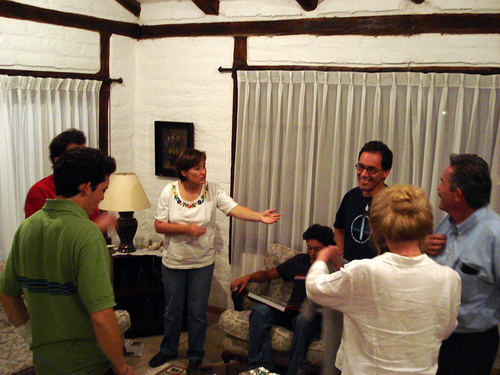In a recent article, I talked about how not to get into an argument. This article picks up on that topic with examples of arguments being headed off by use of non-violent communication.
THEM: Why do you always try to run everything? [This sounds like anger or irritation, and we might guess that the person needs to feel a greater sense of control, or else some recognition.]
YOU: Are you angry because you don’t feel you’re getting a say in what we do tonight?
THEM: Of course I’m angry–duh! I just don’t want to go to that same stupid restaurant. It’s so loud there, I can never hear anything you guys are saying. [Success! This could have turned into an argument about whether or not you do or should always try to run everything; instead it’s turned into a discussion of the relative merits and problems of different restaurants.]
THEM: I can’t believe you made me another stupid sweater!
YOU: You sound angry that I made you a sweater.
THEM: I’m not angry: I’m embarrassed! [Good try with the “angry” thing: even though it was a wrong guess, you now have the information you need.]
YOU: So you don’t feel comfortable wearing the sweaters I make you out.
THEM: I’m sorry, but they’re just not my style. They make me look like an eight-year-old.
YOU: I can understand why you don’t want to look like an eight-year-old.
[At this point, since you have feelings too, and since the other person’s needs have been addressed at least a little, you might be successful in getting the other person to understand how you feel by telling them exactly what your emotions are and what you need–and being careful not to disguise accusations as emotions or demands as needs.]
YOU: I feel really sad now. I put a lot of work into that sweater. I wanted you to know how much you were on my mind.
THEM: Well, crap, I’m sorry. But I really don’t want to look stupid! [Here the other person is showing a little bit of worry that you might not have heard after all. You can reassure the other person that you have.]
YOU: I would have chosen another pattern if I had known then what I know now.
THEM: It’s really sweet of you to put all that time into it, though. [Feeling comfortable that you’ve heard and understood and accept what has been said, the other person now has an easier time looking out for your needs.] If you still want to make me one next year, maybe we could just talk about the style first.
Obviously there’s a lot more that could happen in either of those examples, but I hope they serve to illustrate how these things can work. I must say that I’ve been using this approach for more than a decade now, and I feel it is one of the absolute most useful things I have ever learned in my life. I have used it to work out child custody arrangements, to get back on track with coworkers who are freaking out, to help my son feel understood and supported, to get better service and a bit of real human interaction in stores and restaurants, and in any number of other situations. Here’s hoping that sharing these ideas with you, or at least pointing you to Dr. Rosenberg’s much more thorough treatment of the subject, will offer you some of the advantages I’ve reaped from it myself.
Photo by Search Engine People Blog











